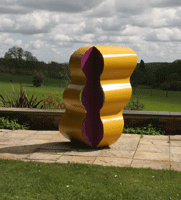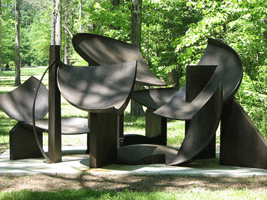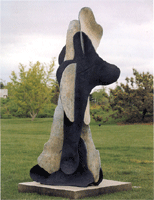Apr 18, 2025
Apr 18, 2025
After finishing his formal studies in 1960, Mr. Witkin worked as an assistant to Henry Moore for two and a half years before returning to St. Martin's to teach. Witkin often credited Moore with 'opening up the heavens' for him as a sculptor. In fact, He became known as one of Moore's most trusted assistants. In fact, Henry Moore's famous 'Locking Piece' (across the Tate Gallery by the Thames), was based upon a bone fragment Isaac Witkin found and gave to Moore. Moore asked Witkin to enlarge this work for him, and, when The Locking Piece got damaged on an international museum tour, Isaac Witkin was the only assistant Moore trusted to dispatch overseas to repair the work. In the biography Henry Moore: The Life and Work of a Great Sculptor, author Donald Hall, wrote in 1963,
'Though some assistants are unhappy in their work ' it's just a job; you don't see enough of Moore, who's always on the telephone, or sitting on a committee in London, or showing visitors around the studios'others like Witkin are enthusiastic. He doesn't want to be influenced by Moore's forms but by his spirit.'
Years later, several of Henry Moore's former assistants, including Anthony Caro, signed a petition in the Times of London denouncing their former employer, and questioning Moore's historic relevance, but Isaac Witkin famously refused to sign it. Moore admitted that he was devastated by the betrayal, but he was always grateful to Isaac for not joining the pack.



In 1965 Isaac Witkin took a teaching position at Bennington College in Bennington, Vt. In the 60's the school was a magnet for modernist artists like Mr. Caro, Kenneth Noland, Paul Feeley and Jules Olitski, who, along with the critic Clement Greenberg, collectively came to be known in the art world as "the Green Mountain Boys." Mr. Witkin taught at Bennington until 1979.
After moving to Bennington, he created welded steel works reflecting the influences of Mr. Caro and David Smith, joining heavy industrial steel forms with complex Cubist compositions. From the late 70's on, he worked mainly in bronze. He poured molten metal into sand molds, creating organic forms that he assembled into monumental sculptures recalling the works of his mentor Moore. By 1985, Grace Glueck of The New York Times wrote that Isaac Witkin 'long ago worked his way out of aesthetic debt to such mentors as Anthony Caro and David Smith and into a powerful lyrical expression of his own.'
Mr. Witkin, who became an American citizen in 1975, moved to New Jersey in the early 80's. In 1981, he was awarded a Guggenheim Fellowship. By the mid 1980's, in 1987 he bought a 22-acre blueberry farm in Pemberton and lived there the rest of his life. Witkin had moved on to work mainly in bronze, creating organic forms that he assembled into monumental sculptures. He was introduced to state of the art casting methods at the Johnson Atelier, whose founder J. Seward Johnson gave Witkin carte blanche to use the facilities. At the Johnson Atelier, Witkin went on to develop his own sculptural language ' of 'drawing' with molten metal onto beds of sand, an innovation unique to 20th century Sculpture. J. Seward Johnson, a sculptor in his own right, went on to become Isaac Witkin's greatest patron, eventually commissioning him to make a 75 ton stone work for the Grounds for Sculpture Art Park in New Jersey, which Mr. Johnson founded.
In 1991, the Philadelphia Inquirer's art critic Edward J. Sozanski declared: 'Witkin seems capable of making bronze do everything but sit up and speak.'
After leaving Bennington, Mr. Witkin held teaching positions at Middlebury College, Parsons School of Design, the Philadelphia College of Art (now part of the University of the Arts) and, most recently, Burlington County Community College in New Jersey.
But the most important of all was his constant voice against the Apartheid regime at his home in South Africa. This was not only expressed vocally but also through his art, in masterworks such as 'Africa', 'Firebird' or 'Masai' that sought to celebrate the magnificent geography and humanistic greatness of South Africa. In his speech on 'Art against Apartheid', the handwritten pages that Nadine found strewn on the floor of her father's house, Issac Witkin wrote:
'Art is a universal language that cuts through barriers of racial prejudice and unites us all with a common thread of humanity. It is the fine membrane of society that accurately reflects the spiritual state of our civilization at any given moment ' our hopes, our dreams, our spiritual yearnings as well as our shortcomings but reminding us always of our essential humanness. I regard my own work as a diary of my spiritual development. An ongoing dialogue with the question of what is this thing called sculpture ' what does it reveal about myself and how does this impact upon the world.
It was the great tradition of indigenous African Sculpture however that arrested my attention. It was the same revelation Picasso must have had when he encountered those great carvings which inspired the Les Demoiselles d' Avignon (the first cubist masterpiece.) Because these carvings were rarely displayed publicly, I had the good fortune to meet someone in the anthropological department of the university where I was allowed to study these works in dimly lit basements.
The politically oppressive climate of South Africa under apartheid and the limited art educational resources determined me to leave my homeland to further my studies abroad. I arrived in London in the late fifties where I had the good fortune to wind up in St. Martins School of Art (A London County Council School). It turned on to be the most vital art school in England at the time.
About his bronze forms, which made him world famous, his visions are -
'..to bypass the conventional method of casting and to use bronze in and of itself and not as a material other materials were translated into. I welcomed the challenge to explore the properties of the material in its primal state and to observe behavioral flow, its texture and surface nature when poured at different temperatures and onto different surfaces.
The images that emerge resulted from the dictates of the forms where concept and process were held in balance, assembled in a redefined constructivist methodology.
My dream was to create a full blooded organic vision and I drew inspiration from James Joyce's words 'The artist forging anew in his workshop out of the sluggish matter of the earth, a new soaring impalpable, imperishable being'.
Isaac made series of recognized masterpieces that arose as a direct response to his roots in Africa. They include works such as:
1. United We Stand (symbolizes the dream of racial unity)
2. Masionoke ("Lightning Bird")
3. Shogun
4. Namibia
5. Firebird (this was the work Isaac exhibited with Dumile)
6. Africa
7. Kosazaan ("African Queen')
9. Angola
10. Masai I & II
11. Love Letter / Congo
12. Gumboot Dancer
13.Dingaan (the Zulu Chief)
20-Jul-2008
More by : Dr. Amitabh Mitra

|
Hi Isaac, I was looking though my files the other day and your name came up as a sculptor. When I looked at your work some of it reminded me of pieces I created in the last 50 or so years. Just to let you know I went to Brooklyn college where I studied with some of the best artists trying to make a living teaching. People like Ad Reinhardt,Burgoyne Diller, Curt Selegmann. After I graduated I went to wok as a graphic designer but I kept on doing my artwork!! www.staneisenman.com |